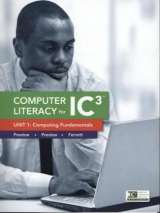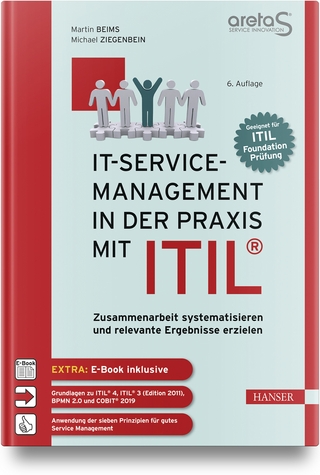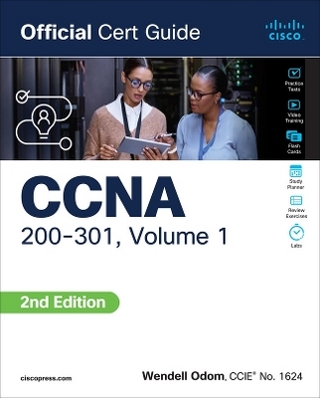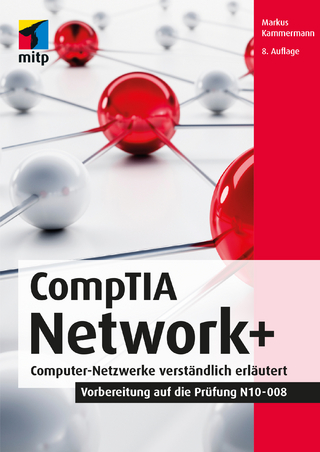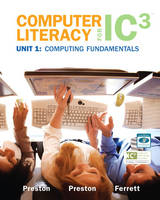
Computer Literacy for IC3, Unit 1
Pearson (Verlag)
978-0-13-501709-8 (ISBN)
- Titel erscheint in neuer Auflage
- Artikel merken
Written to provide all students with an opportunity to learn and demonstrate computer and Internet literacy.
Computer Literary for IC3 was written to align with a certification called “Internet and Computing Core Certification (IC3)”. This certification is for users who want to demonstrate critical computer and Internet skills valued in today’s academic and professional environments. The Computer Literacy for IC3 text is written to meet the certification standards and provide students with a broad understanding of the key components of computer literacy in order to prepare for the exam.
This certification has 3 units:
• Unit 1: Computing Fundamentals (computer concepts)
• Unit 2: Using Productivity Software
• Unit 3: Living Online (the Internet)
Each of these units is available as a separate Computer Literacy for IC3 text. This text contains: Unit 1: Computing Fundamentals and covers basic computer concepts including computer hardware, computer software, and using an operating system.
The second edition of Computer Literacy for IC3 has been revised to keep up with the IC3 program’s evolution, which reflects the recent changes in computers and technology. Instead of publishing one large, comprehensive text, the three units are now available as separate, smaller texts.
Robert L. Ferrett recently retired as Director of the Center for Instructional Computing at Eastern Michigan University, where he provided computer training and support to faculty. He has authored or co-authored more than 80 books on Access, PowerPoint, Excel, Publisher, Windows Vista, WordPerfect, and Word. He has been designing, developing, and delivering computer workshops for nearly two decades. Bob has written for the GO! Series, and was a series editor for the Learn 97, Learn 2000, and Learn XP books. He has a BA in Psychology, an MS in Geography, and an MS in Interdisciplinary Technology from Eastern Michigan University. His doctoral studies are in Instructional Technology at Wayne State University. As a sidelight, Bob teaches a four-week Computers and Genealogy class, and has written genealogy and local history books. Sally Preston teaches computing in a variety of settings, which provides her with ample opportunity to observe how people learn, what works best, and what challenges are present when learning a new software program. The diverse experience provides a complementary set of skills and knowledge that is blended into her writing. Sally has been writing computer textbooks for nearly ten years and has authored books for the GO! Series, the Learn Series, and for theEssential Series. Sally has an MBA from Eastern Michigan University. When she is away from her computer she is often found planting flowers in her garden. John Preston is an Associate Professor at Eastern Michigan University in the College of Technology in the Technology Management program. He has been teaching, writing, and designing computer courses since the advent of PCs, and has authored and co-authored more than sixty books on computer applications and the relationship between technology and society. He teaches courses in global technologies, managing information systems, project management, and quantitative reasoning. He served as program coordinator of the Energy Management program and has trained commercial energy auditors for all of the major utilities in Michigan. Prior to his tenure at EMU, he was a partner in an energy management consulting firm.
Chapter 1: Identifying Types of Computers (1.1.0)
Lesson 1: Identifying Categories of Computers (1.1.1)
Lesson 2: Identifying Basic Components of a Computer (1.1.2)
Lesson 3: Measuring Memory and Identifying Flow of Information (1.1.3)
Lesson 4: Identifying Relationships between Computers (1.1.4)
Chapter 2: Identifying Computer Components and Their Functions (1.1.0)
Lesson 1: Identifying Basic Input and Output Components (1.1.5)
Lesson 2: Identifying Specialized Input Devices (1.1.6)
Lesson 3: Identifying Specialized Output Devices (1.1.6)
Lesson 4: Connecting Devices to a Computer (1.1.8)
Chapter 3: Maintain Computer Equipment (1.2.0)
Lesson 1: Identifying Criteria for Selecting a Personal Computer ()
Lesson 2: Identifying Factors that Affect Computer Performance (1.1.9)
Lesson 3: Identifying Other Factors to Consider When Purchasing a Computer ()
Lesson 4: Protecting Your Computer from Theft or Physical Damage (1.2.1, 1.2.2, 1.2.3)
Lesson 5: Identifying Maintenance Issues (1.2.5, 1.2.6, 1.2.7, 1.2.9)
Lesson 6: Identifying and Solving Hardware Problems (1.2.8)
Lesson 7: Identifying Consumer Rights and Responsibilities (1.2.9)
Chapter 4: Identifying Software and Hardware Interaction and Types of Software
Lesson 1: Identifying How Hardware and Software Interact (2.1.1)
Lesson 2: Identifying Steps of the Software Development Process (2.1.2)
Lesson 3: Identifying Issues Related to Software Distribution, Updates, and Upgrades (2.1.3)
Lesson 4: Identifying Fundamental Word Processing Concepts and Uses (2.2.1)
Lesson 5: Identifying Fundamental Spreadsheet Concepts, Processes, and Uses (2.2.2)
Lesson 6: Identifying Fundamental Presentation Software Concepts and Uses (2.2.3)
Lesson 7: Identifying Fundamental Database Concepts and Uses (2.2.4)
Lesson 8: Identifying Fundamental Graphic and Multimedia Concepts and Uses (2.2.5)
Lesson 9: Identifying Other Types of Software and Their Uses (2.2.6 and 2.2.7)
Lesson 10: Identifying How to Select Software (2.2.8)
Chapter 5: Using an Operating System
Lesson 1: Identifying the Purpose and Functions of an Operating System (3.1.1, 3.1.2, 3.1.3)
Lesson 2: Identifying Capabilities Limitations, and Common Problems (3.1.4 and 3.1.5)
Lesson 3: Identifying Functions of the Control Panel (3.3.1, 3.3.2, and 3.3.5)
Lesson 4: Using the Control Panel (3.3.3 and 3.3.4)
Lesson 5: Installing Software (3.3.6)
Lesson 6: Identifying Common Installation Problems (3.3.7)
Chapter 6: Using Windows
Lesson 1: Identifying Elements of the Desktop and Windows (3.2.1)
Lesson 2: Changing the Size and Position of Windows (3.2.2)
Lesson 3: Shutting Down and Restarting the Computer (3.2.3)
Lesson 4: Using the Windows Start Menu and Taskbar (3.2.4)
Lesson 5: Using Desktop Folders and Icons (3.2.5)
Lesson 6: Managing Files (3.2.6)
Lesson 7: Finding Files and Using the Recycle Bin (3.2.6)
Lesson 8: Managing Removable Storage Media (3.2.6)
Lesson 9: Identifying Precautions and Problems When Working with Files (3.2.7 and 3.2.8)
| Erscheint lt. Verlag | 6.8.2009 |
|---|---|
| Sprache | englisch |
| Maße | 279 x 230 mm |
| Gewicht | 567 g |
| Themenwelt | Informatik ► Weitere Themen ► Zertifizierung |
| ISBN-10 | 0-13-501709-2 / 0135017092 |
| ISBN-13 | 978-0-13-501709-8 / 9780135017098 |
| Zustand | Neuware |
| Haben Sie eine Frage zum Produkt? |
aus dem Bereich
